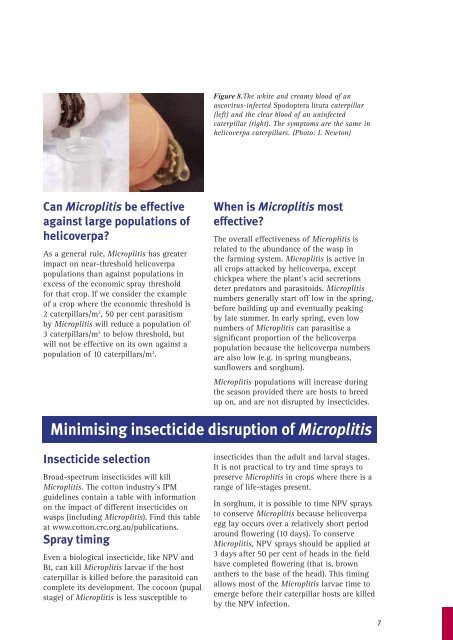Microplitis and ascovirus - Department of Primary Industries
Microplitis and ascovirus - Department of Primary Industries
Microplitis and ascovirus - Department of Primary Industries
You also want an ePaper? Increase the reach of your titles
YUMPU automatically turns print PDFs into web optimized ePapers that Google loves.
Figure 8.The white <strong>and</strong> creamy blood <strong>of</strong> an<br />
<strong>ascovirus</strong>-infected Spodoptera litura caterpillar<br />
(left) <strong>and</strong> the clear blood <strong>of</strong> an uninfected<br />
caterpillar (right). The symptoms are the same in<br />
helicoverpa caterpillars. (Photo: I. Newton)<br />
Can <strong>Microplitis</strong> be effective<br />
against large populations <strong>of</strong><br />
helicoverpa?<br />
As a general rule, <strong>Microplitis</strong> has greater<br />
impact on near-threshold helicoverpa<br />
populations than against populations in<br />
excess <strong>of</strong> the economic spray threshold<br />
for that crop. If we consider the example<br />
<strong>of</strong> a crop where the economic threshold is<br />
2 caterpillars/m 2 , 50 per cent parasitism<br />
by <strong>Microplitis</strong> will reduce a population <strong>of</strong><br />
3 caterpillars/m 2 to below threshold, but<br />
will not be effective on its own against a<br />
population <strong>of</strong> 10 caterpillars/m 2 .<br />
When is <strong>Microplitis</strong> most<br />
effective?<br />
The overall effectiveness <strong>of</strong> <strong>Microplitis</strong> is<br />
related to the abundance <strong>of</strong> the wasp in<br />
the farming system. <strong>Microplitis</strong> is active in<br />
all crops attacked by helicoverpa, except<br />
chickpea where the plant’s acid secretions<br />
deter predators <strong>and</strong> parasitoids. <strong>Microplitis</strong><br />
numbers generally start <strong>of</strong>f low in the spring,<br />
before building up <strong>and</strong> eventually peaking<br />
by late summer. In early spring, even low<br />
numbers <strong>of</strong> <strong>Microplitis</strong> can parasitise a<br />
significant proportion <strong>of</strong> the helicoverpa<br />
population because the helicoverpa numbers<br />
are also low (e.g. in spring mungbeans,<br />
sunflowers <strong>and</strong> sorghum).<br />
<strong>Microplitis</strong> populations will increase during<br />
the season provided there are hosts to breed<br />
up on, <strong>and</strong> are not disrupted by insecticides.<br />
Minimising insecticide disruption <strong>of</strong> <strong>Microplitis</strong><br />
Insecticide selection<br />
Broad-spectrum insecticides will kill<br />
<strong>Microplitis</strong>. The cotton industry’s IPM<br />
guidelines contain a table with information<br />
on the impact <strong>of</strong> different insecticides on<br />
wasps (including <strong>Microplitis</strong>). Find this table<br />
at www.cotton.crc.org.au/publications.<br />
Spray timing<br />
Even a biological insecticide, like NPV <strong>and</strong><br />
Bt, can kill <strong>Microplitis</strong> larvae if the host<br />
caterpillar is killed before the parasitoid can<br />
complete its development. The cocoon (pupal<br />
stage) <strong>of</strong> <strong>Microplitis</strong> is less susceptible to<br />
insecticides than the adult <strong>and</strong> larval stages.<br />
It is not practical to try <strong>and</strong> time sprays to<br />
preserve <strong>Microplitis</strong> in crops where there is a<br />
range <strong>of</strong> life-stages present.<br />
In sorghum, it is possible to time NPV sprays<br />
to conserve <strong>Microplitis</strong> because helicoverpa<br />
egg lay occurs over a relatively short period<br />
around flowering (10 days). To conserve<br />
<strong>Microplitis</strong>, NPV sprays should be applied at<br />
3 days after 50 per cent <strong>of</strong> heads in the field<br />
have completed flowering (that is, brown<br />
anthers to the base <strong>of</strong> the head). This timing<br />
allows most <strong>of</strong> the <strong>Microplitis</strong> larvae time to<br />
emerge before their caterpillar hosts are killed<br />
by the NPV infection.<br />
7
















